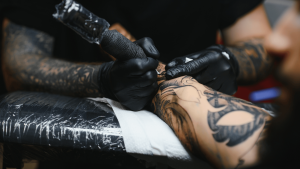The skincare world has never been more active. With McKinsey estimating that by 2027, the beauty industry will record $580 billion of retail sales, the market is flooded with skincare products and finding the right one is near-impossible. New products launch every week and social media is full of must-try skincare. But with this information overload comes a rise in confusion and we may unintentionally damage our skin by following routines that are too harsh or simply unsuitable.

A 2024 CeraVe survey showed that 71% of users get skincare advice from social media even when unsure of its accuracy, proving how easy it is to fall into skincare mistakes without realising. The key is to embrace your individuality, make informed decisions, and prioritize self-care. This guide breaks down the most common skincare errors and explains how to fix each one using real examples and insights.
Over-Cleansing Or Using Harsh Cleansers
While some of us may believe that taking a “more is better” approach to skincare is the answer, this isn’t always the case when it comes to cleansing. Cleansing too frequently or using high-pH cleansers strips away the skin’s natural oils and damages its protective barrier. This can lead to a tight, dry and flaky feeling, increased redness and sensitivity, and a cycle of more oil production and breakouts, as the skin tries to compensate. Dermatologists often recommend CeraVe Hydrating Cleanser, cream cleansers like Cetaphil Gentle Skin Cleanser or oil cleansers such as Burt’s Bees Cleansing Oil.
How to Fix It
- -Use a gentle, pH-balanced cleanser and limit cleansing to twice a day.
- -If you are active, you may need to wash more, but use a gentle cleanser.
- -Wash with lukewarm water as hot water can further strip the skin.
- -Avoid harsh scrubbing and be gentle when washing your face.
- -Follow up with a moisturiser to help replenish and support your skin barrier.
Skipping Sunscreen — Even Indoors
You should not skip sunscreen indoors because UVA rays penetrate glass and are responsible for premature ageing, pigmentation and uneven texture and an increased risk of skin cancer. The Skin Cancer Foundation reports that up to 90% of visible skin ageing is caused by UV exposure, not genetics. Additionally, the blue light from electronic devices can cause skin pigmentation and damage. Wearing a broad-spectrum sunscreen with SPF 30 is a good practice for indoor exposure although re-application is advised when heading out. La Roche-Posay Anthelios is widely used in dermatology for its broad-spectrum protection and lightweight finish, making it ideal for daily wear.
How to Fix It
- -To protect your skin while indoors, choose a sunscreen that protects against both UVA and UVB rays.
- -An SPF of 30 is generally sufficient for indoor exposure, but SPF 35+ or 50 may be better if you sit near a window for long periods.
- -Sunscreens containing physical blockers like zinc oxide or titanium dioxide offer better protection against blue light than chemical sunscreens.
- -Apply sunscreen to face, neck, ears and hands as part of your morning skincare routine.
- -Reapply every 4 to 6 hours if you are sitting near a window or using digital screens for extended periods.
RELATED ARTICLES
AI-Powered Personalised Skincare
Ultimate Guide To Top Skincare Products For A Glowing Complexion

Layering Too Many Active Ingredients
Mixing retinol, AHAs, BHAs or strong vitamin C formulas without guidance can overwhelm and irritate the skin, leading to dryness, redness, or breakouts. Instead of mixing them, alternate them in your skincare routine, using vitamin C in the morning and retinol or acids at night, and always introduce new active products gradually to see how your skin reacts. The Ordinary has clear ingredient-conflict guidelines noting combinations that should not be used together, helping users avoid accidental reactions.
How to Fix It
-Do not use retinol and strong acids like AHAs/BHAs in the same routine. Instead, use an AHA/BHA in the morning or on one night, and use a retinol on another night.
-Use vitamin C in the morning to protect against environmental damage. Use retinoids and strong acids at night, as they can increase sun sensitivity.
-Don’t use vitamin C with benzoyl peroxide: Benzoyl peroxide can oxidize and render vitamin C ineffective, so keep these products separate.
-Introduce only one new active ingredient at a time to allow your skin to adjust and to identify which product might be causing irritation.
-Always follow serums with a moisturizer to help counteract dryness and support your skin barrier.
Not Moisturising Oily Or Acne-Prone Skin
Skipping moisturiser on oily or acne-prone skin can cause your skin to produce more oil, which can clog pores and lead to breakouts. To avoid this, choose a lightweight, oil-free and non-comedogenic moisturizer that won’t clog pores, such as a gel-based one, to keep your skin hydrated and balanced. Clinique Dramatically Different Gel became popular for oily skin because it hydrates without heaviness or pore-clogging ingredients.
How to Fix It
- -Use lightweight, non-comedogenic gels or emulsions. These are designed to hydrate without adding excess oil or clogging pores.
- -Consider gel or water-based moisturisers that feel less heavy on the skin.
- -Look for beneficial ingredients like niacinamide, salicylic acid, and aloe vera that can help manage oil and acne.
- -Using an oil-free sunscreen is still crucial to protect your skin.
Skipping Patch Tests
Fragrances, essential oils and preservatives can cause allergic reactions. Skipping patch tests is not recommended and can lead to inaccurate results for identifying allergies or irritants. Professional patch tests involve a doctor placing allergens on your back for 48 hours and then performing follow-up readings to detect a delayed reaction. Skipping these follow-up readings, removing the patches, or getting them wet can prevent you from receiving a proper diagnosis. Brands like Paula’s Choice and Kora Organics explicitly advise patch testing before using strong actives like AHAs, BHAs or retinol.
How to Fix It
- -Test on a small area for 24–48 hours before full application, even if your skin feels itchy or sore. Do not remove, scratch, or loosen them.
- -Do not get the test area wet. Avoid showers, swimming, and heavy sweating.
- -Follow your doctor’s instructions regarding topical creams, oral steroids, and sun exposure both before and during the test period.
- -Make sure to attend all follow-up appointments. Your doctor needs to examine your skin multiple times to see if a delayed reaction has occurred.
Following TikTok DIY Skincare Trends
The Risk
When following TikTok skincare trends, be cautious of potential risks like skin damage and infection, especially with DIY methods, and prioritize consulting a dermatologist for personalized advice. While some trends like micellar water, skin cycling, and the “retinol sandwich” technique may be beneficial, others like DIY dermaplaning or pore vacuums can be risky. Always approach trends with a healthy dose of skepticism and a professional’s guidance. Instead of DIY scrubs or acids, professionally tested formulas like Dr. Dennis Gross Alpha Beta Peels offer results with controlled concentrations.
How to Fix It
- -Stick to safe, science-backed formulations.
- -Always get advice from a board-certified dermatologist before trying new or potentially risky trends.
- -Don’t rely solely on social media for skincare advice. Look for information from reputable sources.
- -What works for one person may not work for you. Your skin type and concerns should guide your choices.
- -For treatments like dermaplaning or extractions, it is safer to see a professional than to attempt them at home.
Sleeping With Makeup On
Makeup traps dirt, pollution and oil overnight. Sleeping with makeup on is not recommended because it can lead to clogged pores, breakouts, and premature aging. It can also cause skin irritation, dry skin, and damage your eyelashes. To avoid these issues, it is best to remove all makeup before going to bed with a thorough cleansing routine. Clinique Take the Day Off Balm is often recommended by dermatologists for its ability to break down SPF and long-wear makeup without harming the barrier.
How to Fix It
- -Use a gentle cleanser to wash your face and remove the bulk of your makeup.
- -For waterproof or long-wearing products, use micellar water on a cotton pad. Gently press and hold the pad on your eyelids to loosen mascara and eyeliner before wiping them off.
- -If you wear a lot of makeup or sunscreen, a double-cleansing method can ensure your pores are completely clear, according to Sublime Life.
- -After cleansing, apply a moisturizer to hydrate your skin overnight and help with the renewal process.

Using Too Much Product
Using too much skincare product can lead to skin irritation, breakouts, and dryness, and can worsen existing conditions like acne or eczema. Signs include increased redness, flaking, or a feeling of tightness, as well as “product pilling,” where products roll up on the skin. To avoid this, it’s better to simplify your routine to include a cleanser, moisturizer, and sunscreen, and to introduce new products one at a time to see how your skin reacts.
How to Fix It
- -A simple routine of a cleanser, moisturizer, and sunscreen is often enough for healthy skin.
- -Add one new product at a time to help identify which product might be causing a reaction.
- -If you have a specific concern, add a serum or treatment product gradually, and always follow the directions for use.
- -Limit exfoliation to once or twice a week to avoid damaging your skin barrier.
- -Pay attention to how your skin feels and adjust your routine accordingly. What works for one person may not work for another.
Over-Exfoliating
Over-exfoliation is a skin condition caused by exfoliating too frequently or aggressively, which damages the skin’s protective barrier. Key signs include redness, irritation, dryness, and increased sensitivity, but it can also lead to breakouts and an uneven skin tone. To recover, focus on gentle, hydrating products and give your skin a break from exfoliants for a few weeks. Products like Pixi Glow Tonic and Clinique For Men™ Exfoliating Tonic de-flakes, unclogs pores and smooths skin.
How to Fix It
- -Reduce chemical exfoliation to 1–2 times a week.
- -Wash with a mild cleanser and use a non-irritating, hydrating moisturizer. Look for ingredients like glycerin and ceramides to help restore your skin’s barrier.
- -Apply a cool compress or a calming ingredient like aloe vera to reduce redness and inflammation.
- -Apply sunscreen daily to protect your compromised moisture barrier from UV damage.
- -If your skin is severely raw or painful, it is best to seek professional advice.

Jasmeen Dugal is Associate Editor at FashionABC, contributing her insights on fashion, technology, and sustainability. She brings with herself more than two decades of editorial experience, working for national newspapers and luxury magazines in India.
Jasmeen Dugal has worked with exchange4media as a senior writer contributing articles on the country’s advertising and marketing movements, and then with Condenast India as Net Editor where she helmed Vogue India’s official website in terms of design, layout and daily content. Besides this, she is also an entrepreneur running her own luxury portal, Explosivefashion, which highlights the latest in luxury fashion and hospitality.












